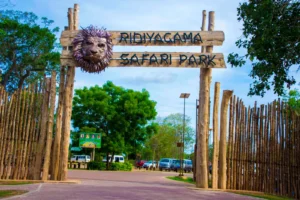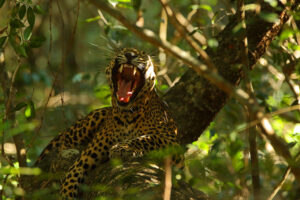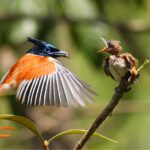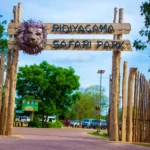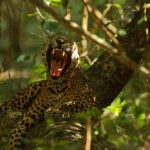Kumana National Park – Yala-East for World-Class Wildlife Experiences
Situated in the south-east corner of Sri Lanka, the 18,149-hectare Kumana Yala-East National Park is also a well-known eco-tourism destination and bird park where a plethora of birds breed and build nests. One of the most prominent aspects of the park is the “Kumana Villu,” which is a 200-hectare natural marsh lake, flourished by the Kumbukkan Oya by a half-mile long narrow canal. It is in this mangrove marsh where several aquatic birds breed in May and June. Daily sightings involve bird populations such as pelicans, white ibis, painted storks, spoonbills, herons, egrets, and small cormorants.
A really rare black-necked stork has indeed been spotted in the marsh. Other than the abundant birdlife, Kumana national park is also host to some of the species present in the broader Yala National Park (west), such as elephants and leopards. The flora in Kumana mainly consists of mangrove trees, kumbuk and Karan ferns, and also the open marsh forest. For bird watching lovers, the park is an “utter must.”
Why visit Kumana National Park?
Encircled by 20 lagoons and tanks that lead to a spectacular bird community, you are likely to be struck by the majesty of the park and its variety, like the mysterious leopard, the sloth bear, and the elephants that walkabout. The mystical atmosphere in the quiet forest where the typical flame torches light up and rage to the music of the wind, as the campfire dances beneath the clear night sky, is the spot to settle down and relax while you have the best time of your life.
The Kumana Bird Sanctuary, within the boundaries of Kumana National Park, was designated a nature preserve in 1938 and is considered to be among the most significant breeding grounds for birds in Sri Lanka. A total of 255 bird species have been recorded in Kumana, making it a top-rated bird-watching site in Sri Lanka.
Kumana is also host to some of the species contained in the nearby Yala National Park like elephants and leopards that can also be seen on safari. Other species that live within Kumana National Park provide the Golden Jackal, the European Otter. Up to 30-40 Sri Lankan elephants are also confirmed to live in the park, but they move over to Yala National Park.
The grassland areas of the park are covered by dry tropical thorn woodland. The vegetation of the inland forest consists mostly of Manilkara hexandra, classified as Palu in Sinhalese. There are also a variety of water species, trees, and ferns.
Ancient cave markings dating all the way back to the 1st and 2nd Centuries BC have been found here. Every year, Buddhist and Hindu followers cross the Kumana region on their foot trek to the neighboring Temple of Kataragama.
All in all, Kumana National Park in Sri Lanka is a must-visit destination by all nature lovers.
What is the best time to visit Kumana?
Kumana National Park can possibly be accessed at any time of year, but you must be mindful of the monsoons during those months, as torrential downpours can have a huge effect on your travel experience.
The dry season typically lasts from February to July, and this is the perfect time to visit Kumana since the species are far easier to find in less dense foliage.
The rest of each year, the park sees flooding and monsoons, and the paths can become damp in the already muddy climate so that transport can become more challenging, but far from unlikely.
The dry season is usually the peak season, but relative to the park in the west, Kumana sees just a fraction of the number of tourists and you can always appreciate a quiet trip even in the peak of months.
Bird Watching in Kumana National Park
One of the most extensive bird sanctuaries in Sri Lanka is in place within the Kumana National Park. This is the best place to visit in the country if you’re interested in discovering the oddest bird species found around the world.
As already mentioned, the great season to visit is between February-April and July, as birds practically migrate to Kumana National Park. The sanctuary maintains a breeding ground that is an important part of the protection of all of these rare species of birds, and it is reported that over 200 unique species can be found in the park. During the breeding season, you can notice thousands and thousands of birds moving to Kumana to notice a secure place for breeding.
Swamps and reservoirs are an ideal refuge for many uncommon and threatened species, and at the right time of year, you are sure to find almost everything within the nature reserve. Some of the most common species present here are waterfowl and wading birds that love wet weather, while birds as varied as storks, moorlands, ducks, and ibis can be present here.
Some species, such as pintails, often migrate more than 5000 miles from Russia to the warmer climates of Sri Lanka to nest here, an incredible feat of stamina and coordination that is hard to understand.
Wildlife Safaris in Kumana National Park
Kumana National Park is a habitat with several of Sri Lanka’s most endangered wildlife species. There are several various wildlife other than hundreds of bird species in the forest.
The swampy environment and the prolific amount of water tanks and reservoirs render this a relatively excellently-conditioned place for reptiles and water-based animals. There are several other creatures in the waterlogged environment, including several various types of tortoises, otters, and, of course, crocodiles.
The western part of Yala National Park appears to be home to many of the country’s larger wildlife, although, in smaller numbers, there are also endangered populations of elephants, wild boars, and sometimes uncommon Sri Lankan leopards and sloths.
Wildlife safaris in Kumana is a great choice when you visit Sri Lanka for an authentic wildlife experience. Anyway, it’s best if you plan to visit other national parks in the country for a complete wildlife expedition.
Kumana National Park Camping
Camping and luxurious tent safari camping in Kumana National Park offers an incredible privilege of dealing with untamed wildlife in Sri Lanka. You can live in interaction with a varied population of mammals, snakes, and aquatic animals. Many camping service providers deliver stunning luxury camping safari, professionally trained naturalists/guides along with exotic Sri Lankan cuisine.
Be with nature, you’re going to get a wake-up call from the wilderness!!! Enjoy new, nutritious meals cooked in the wild kitchen by trained chefs. Experience a true wildlife safari guided by a famed naturalist where you can have a fun, informative, and pleasant wildlife trip. Head to the cool dip of the local river with a cold bottle under the stars.
Lie beneath the wild untouched stars!!! An amazing life story. Safari camping in Kumana National Park is among the most favored tent safari camps in Sri Lanka. Kumana National Park spans a region of 18,200 hectares and contains wildlife comprising leopards, tigers, bears, and birds among the thousands of fauna and flora organisms that render this park a complex ecosystem.
What are the best hotels near Kumana?
- Stay Golden
- The Bavarian Resort
- The Spice Trail
- Royal Point Arugambay
- East Surf Cabanas
- Lucky Bay
- Jetwing Yala
- Upali Beach Surf Resort
- The Danish Villa Hotel
How to travel from the Airport to Kumana?
Alright, you have many options to consider. However, the distance from the airport to the Kumana National Park is one prime concern here. It’s about 400 kilometers from the airport to the park, as the road to take is not a straight one.
You can pick a bus, rail, and private vehicle or taxi for this long journey. It’s best you plan the trip with a reputable local travel agency like us. We can provide you with a driver and luxury car to make it smooth and comfortable.
Kumana National Park in Sri Lanka is one of the best choices for bird watching and wildlife safaris, camping. Contact us today and book your Kumana holiday package!


